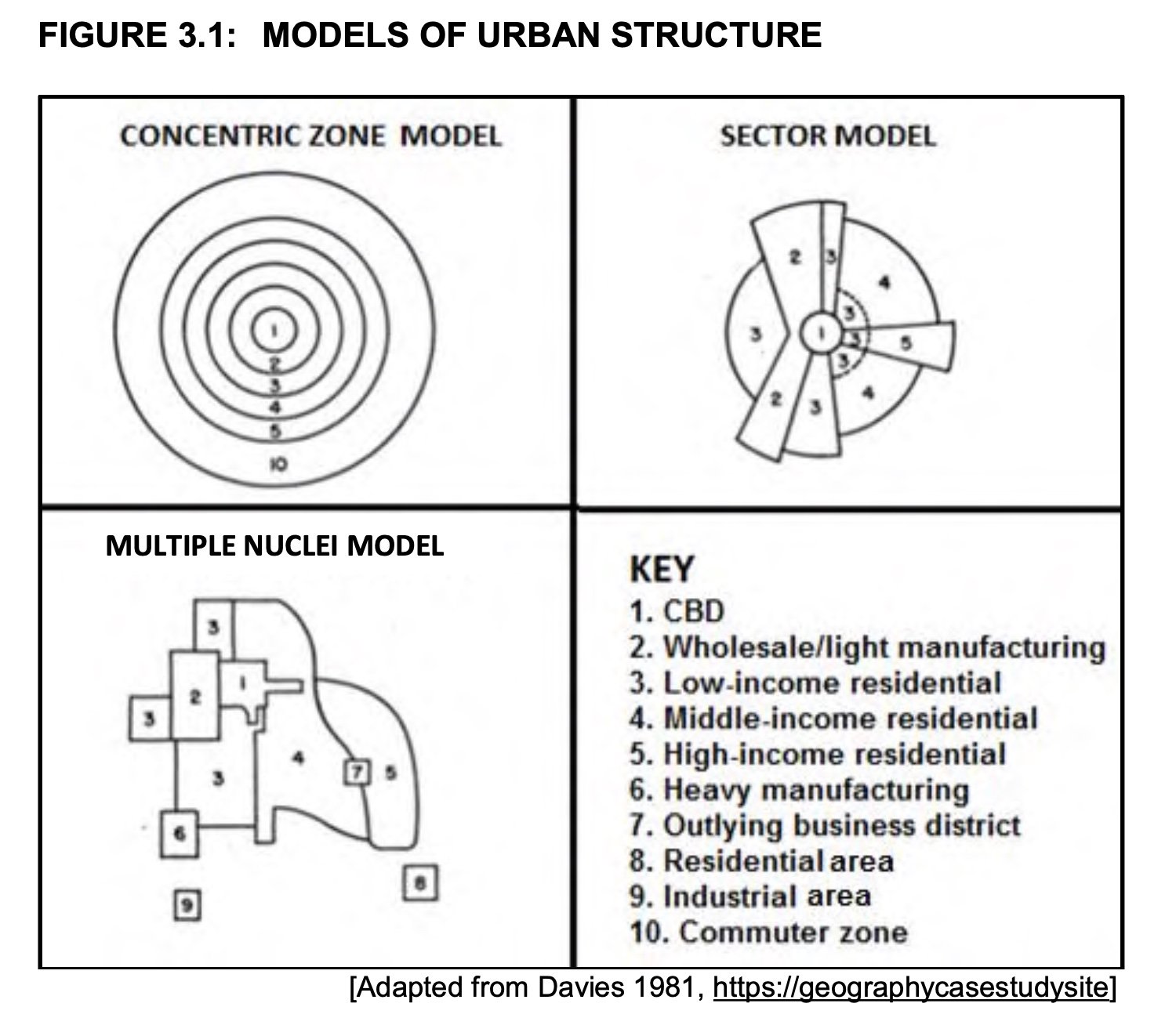Economic Geography Grade 12 Questions and Answers
26 August 2021 2021-08-26 10:10Economic Geography Grade 12 Questions and Answers
Economic Geography Grade 12 Questions and Answers
Economic Geography Grade 12 Questions and Answers:
Refer to FIGURE 3.1 showing models of urban structure. Choose the correct answer from the options given in brackets to make the statement TRUE. Write only your answer next the question numbers

- The model which shows land use arranged in wedges is known as the (multiple nuclei/sector) model. Answer:
- In the (multiple nuclei/concentric zone) model the CBD is the focal point around which the urban area develops.
- Industries and low-cost housing develop along main roads or railways in the (concentric zone/sector) model.
- The (sector/multiple nuclei) model is most applicable to modern cities.
- The (sector/concentric zone) model does not consider development along transport routes.
- Cities that have several focal points around which urban development occurs are examples of the (concentric zone/multiple nuclei) model.
- The (sector/multiple nuclei) model displays characteristics of the concentric zone model.
Answers:
- Sector
- Concentric zone
- Sector
- Multiple Nuclei
- Concentric zone
- Multiple Nuclei
- Sector
Refer to FIGURE 3.3, a graph on rural depopulation

- Define the concept rural depopulation.
- Determine the number of people living in the rural areas of
South Africa in 2004. - Is the rural population showing an increase or a decrease from 2004
to 2020? - How will this trend (the answer to QUESTION 3.) have a negative impact on the standard of living of the rural population?
- Explain TWO social factors that contributed to rural depopulation in
South Africa. - Suggest TWO sustainable strategies to encourage people to return
to rural areas.
Answers
- Decrease in population numbers in rural areas (1)
- 21-23 million (1)
- Decrease (in population numbers) (1)
- How will Decrease (in population numbers have a negative impact on the standard of living of the rural population?
- Less people paying for municipal services (market) resulting in less municipal services available (2)
- Decrease in customers/buying power as people leave the rural areas
- Results in businesses closing and an increase in unemployment (2)
- Closing of basic services (accept examples) (2)
- Brain drain as skilled people leave the area (2)
- Less investment as the area becomes a ghost town (2)
- Decrease in production as there are more old people and fewer labourers (2)
- Increasing crime brings stress to the people living in the settlement/ increase in crime/ social ills on the (vulnerable) population left in rural areas (2)
- Property values decrease (2)
- Poverty increases (2)
- Local economy stagnates results in less employment (2)
- Increase in child headed families (2)
- Higher dependency on social services (2)
- Travel further to serviced towns (2)
- Explain TWO social factors that contributed to rural depopulation in South Africa.
- Unemployment due to businesses closing down (2)
- Mechanisation requires less manual labour and leads to unemployment (2)
- Increase in crime due to lack of policing (2)
- Lack of recreational/cultural/entertainment facilities due to lack of investment (2)
- Increase in poverty due to unemployment/low salaries (2)
- Poor basic services (accept examples) due to less people/investment (2)
- Travel long distances to access tertiary education (2)
- Low salaries cause people to move to urban areas to seek better paying jobs (2)
- Farm killings creates fear and forces farmers to move to urban areas (2)
- The slow pace of finalising the land reform is frustrating and forces people to move (2) Lack of professional services in the rural areas causes people to seek those services elsewhere (2)
- Pull factors (from an uban perspective):
- Accessibility to better and efficient services in urban areas (accept explained examples) (2) Greater variety of recreational activities attracts young adults (2)
- Higher standard of living/higher wages in urban areas due to dominant secondary and tertiary activities (2)
- Greater job opportunities in urban areas due to high concentration of economic activities (2)
- Suggest TWO sustainable strategies to encourage people to return
to rural areas.
- Acceleration of land reform to enable the poor and landless to obtain land for farming (2)
- Create job opportunities through the decentralisation of industries from urban areas (2)
- Improve work conditions and salaries (2)
- Change ownership of land from communal to private land ownership (2)
- Employment will increase local market’s buying power resulting in further businesses opening up (2)
- Creating tourism opportunities that would lead to more revenue/business opportunities for rural community (2)
- Improving services in rural areas (accept examples) (2)
- Tax rebates and other incentives to attract industries to re-locate to the rural area (2)
- Making cheaper industrial sites available (2)
- Incentives (accept examples) for professional people coming to work in rural areas (2)
- Improving infrastructure such as roads for people to easily access services (2)
- Hosting festivals in the rural areas to create income (2)
- Promote rural areas as peaceful with aesthetic beauty (2)
- Examples of eco-tourism, eco-estates (2)
- Development of retirement villages (2)
- Introduce measures (accept examples) to reduce crime (2)
Questions and Answers
My Courses has a large Questions and Answers repository for the most popular High School and Tertiary Schools subjects. This comes in handy when doing your revision or preparing for exams, tests, research tasks, and assignments.





